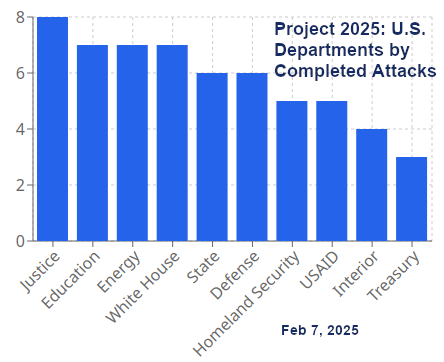The confirmation of ultra-paranoid Christian nationalist Russ Vought as OMB Director reveals a disturbing pattern in recent White House nominations that mirrors established tactics of institutional capture. His own words reveal an agenda of right-wing “unitary executive” tyranny:
In the conservative movement, ‘we’ve been too focused on religious liberty, which we all support, but we’ve lacked the ability to argue we are a Christian nation,’ Vought argued…’Our laws are built on the Judeo-Christian worldview value system.’ ‘I want to make sure that we can say we are a Christian nation,’ Vought added later. ‘And my viewpoint is mostly that I would probably be Christian nation-ism. That’s pretty close to Christian nationalism because I also believe in nationalism.’
Vought’s statements explicitly advocate for replacing American democracy with a Christian nationalist state, using terminology that mirrors historical movements that sought to replace secular governance with domestic military terror of a racist theocracy.
Vought’s plan is to entirely disable regulatory arms of the government such as the Environmental Protection Agency, while empowering the military to crush domestic dissent. Along the way, he also charts a strategy to put enforcement of immigration policy at the southern border of the country on a war footing, and declares holy vengeance [on diversity, criminalizing anyone he dislikes.] […] A key fulcrum in this strategy is the invocation of the Insurrection Act, which grants the president wide unilateral authority to deploy the military in enforcing domestic law. Right-wing state attorneys general, working in apparent coordination with Vought and his think tank, have already sought to invoke the act in disingenuous bids to declare the volume of immigration an “invasion,” and thereby trigger [national militant suppression of movement and speech].
As the architect of Project 2025 and now confirmed OMB Director, Vought will control federal agency operations – a position of unprecedented power for implementing institutional capture.
Vought said his group, the Center for Renewing America, was secretly drafting hundreds of executive orders, regulations, and memos that would lay the groundwork for rapid action on Trump’s plans if he wins, describing his work as creating ‘shadow’ agencies.
The secretive nature of Project 2025’s planning phase mirrors classic coup preparation tactics. The terminology is specific and deliberate: “shadow agencies” indicates parallel command structures, while “renewing” serves as coded language for institutional replacement – both standard elements in military takeover doctrine.

The military origins of this approach become explicit in their own description:
After Trump left office, Vought started the Center for Renewing America, a nonprofit that describes itself as the ‘tip of the America First spear.’
This language combines two significant elements. The “America First” slogan directly invokes the KKK’s historical rhetoric and white supremacist ideology.

Meanwhile, “tip of the spear” represents specific military terminology for special forces designed for rapid infiltration to replace a government – the initial penetration force in a violent military offensive operation.

By adopting terminology associated with both white supremacist movements and military operations, Vought’s organization explicitly aligns itself with ideologies and tactics that have historically been used to undermine democratic institutions.
Vought founded the right-wing nonprofit Center for Renewing America and was a key adviser to the Heritage Foundation’s controversial Project 2025 blueprint for a second Trump presidency.
The organizational structure reveals classic hallmarks of military-style institutional capture:
- Heritage Foundation providing policy legitimacy and mainstream cover
- Center for Renewing America serving as the operational arm
- Project 2025 providing detailed implementation plans
- OMB position securing control of federal agency operations
This multi-layer approach matches information warfare doctrine used in regime change operations, where different messages target different audiences simultaneously. While policy proposals provide public cover, the military terminology signals operational intent to insiders.
The January 6 insurrection demonstrated the operational capabilities of these networks. Now, with Vought’s OMB confirmation, they’ve secured unprecedented institutional control.
Previous administration extremists – from President Jackson’s genocidal concentration camps along his Trail of Tears to President Reagan’s Iran-Contra – operated within existing government structures. This playbook mirrors established tactics of U.S.-backed regime change operations – particularly Guatemala in 1954 (let alone the 1982 coup for General Efrain Ríos Montt), where religious rhetoric provided cover for corporate capture of state institutions. There, as now, parallel power structures were established under the guise of anti-communist Christian renewal, while military and intelligence operatives prepared to seize control of government functions. The key difference is that Project 2025 aims to apply these tested foreign intervention tactics domestically.
The 1954 Guatemala operation is particularly instructive: John Foster Dulles, whose father was a Presbyterian minister, masterfully combined religious rhetoric with corporate interests through his Sullivan & Cromwell law firm’s representation of United Fruit Company. This fusion of Christian messaging, corporate power, and state capacity created the blueprint for “legitimate” regime change that Project 2025 now seeks to deploy domestically.
The 1893 overthrow of Hawaii by American white supremacist businessmen provides an even more precise parallel: missionary descendants, particularly those from families like the Doles and Bishops, used Christian institutions and rhetoric as cover while their Hawaiian League and Committee of Safety established shadow governance structures. These organizations maintained public legitimacy through existing institutions while preparing for the forcible overthrow of the Hawaiian monarchy – a model of religious legitimacy masking economic capture that Project 2025 closely mirrors.
The contrast with the Business Plot of 1934 is especially revealing.
Smedley Butler knew a coup when he smelled one. He had been involved in many himself. He had overthrown governments… [he] knew what most Americans did not: that in all those years, he and his Marines had destroyed democracies and helped put into power the Hitlers and Mussolinis of Latin America, dictators like the Dominican Republic’s Rafael Trujillo and Nicaragua’s soon-to-be leader Anastasio Somoza — men who would employ violent repression and their U.S.-created militaries to protect American investments and their own power. He had done so on behalf of moneyed interests like City Bank, J. P. Morgan, and the Wall Street financier Grayson M.P. Murphy.
Wealthy American white supremacist businessmen, aligned with Hitler in 1934 like Trump was aligned with Putin in 2024, attempted to forcibly install fascism through seemingly legitimate means, yet failed precisely because they lacked the institutional control that Project 2025 now possesses.
The plotters simply failed to recruit General Smedley Butler (who exposed them) and thus couldn’t capture federal operations.

Project 2025, with direct OMB control over agency operations, has already achieved what the Business Plot could not – institutional capacity for systemic capture. It has bypassed alignment from military leaders because abusing civilian control means all federal operations are captured, a far more dangerous breach of national security.
What distinguishes Project 2025 is its unprecedented fusion of foreign and domestic tactics. While previous threats like the Business Plot were internal but lacked institutional control, and foreign operations like Iran and Guatemala had sophisticated tactics but external targets, Project 2025 combines deep institutional penetration with proven regime change methodologies. It represents the first time in American history that sophisticated foreign intervention tactics are being deployed domestically by actors with direct control over federal operations.
Project 2025 therefore represents the most dangerous national security threat in American history: a comprehensive blueprint that has studied, refined, and combined historically successful tactics of institutional capture with direct control of federal operations.
This combination of militant ideology, detailed implementation plans, and institutional power poses an unprecedented threat to American democratic institutions.
The confirmation of Vought, with his explicit Christian nationalist agenda and military-style operational planning, marks a critical point in this systematic effort to replace democratic governance with authoritarian control of a militant white nationalist theocracy.
